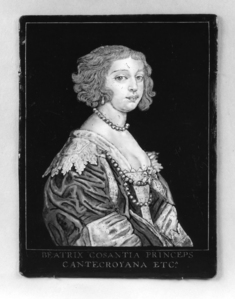Portrait of Charles, Prince of Lorraine
(Baroque Europe )
The prince, at the age of seventeen, is shown half-length, his face framed in long curls and turned three-quarters to the left. He wears armor, over which is a falling linen collar with square ends edged with wide lace and fastened by a cord with tasseled ends. The collar covers the upper part of a scarf thrown over the right shoulder. In the right upper corner appears a coat-of-arms quartered in eight: 1: Hungary; 2: Anjou-Sicily; 3: Jerusalem; 4: Aragon; 5: Anjou (modern); 6: Brabant; 7: Guelderland; 8: Bar; over all: Lorraine. The crest is a closed ducal coronet.
The portrait is after an early engraving by the Dutch artist Abraham de Blois. The subject was born in 1643. He succeeded his uncle, Charles IV, as Duke of Lorraine in 1675 under the name of Charles V. He died in 1690.
Inscription
Provenance
Provenance (from the French provenir, 'to come from/forth') is the chronology of the ownership, custody, or location of a historical object. Learn more about provenance at the Walters.
George Robinson Harding, New York [date and mode of acquisition unknown]; Henry Walters, Baltimore, 1918, by purchase; Walters Art Museum, 1931, by bequest.
Geographies
France, Limoges (Place of Origin)
Measurements
H: 6 7/8 x W: 5 1/16 in. (17.4 x 12.8 cm)
Credit Line
Acquired by Henry Walters, 1918
Location in Museum
Not on view
Accession Number
In libraries, galleries, museums, and archives, an accession number is a unique identifier assigned to each object in the collection.
In libraries, galleries, museums, and archives, an accession number is a unique identifier assigned to each object in the collection.
44.44



